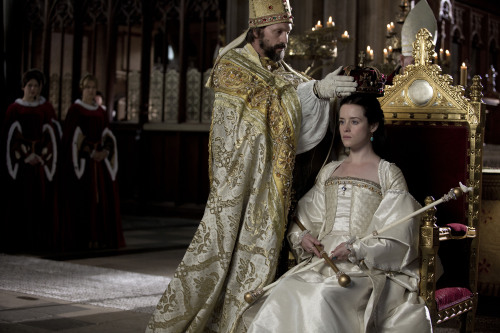minervacasterly: On Whitsunde, the first of June 1533, Anne Boleyn was carried in a litter from West
minervacasterly: On Whitsunde, the first of June 1533, Anne Boleyn was carried in a litter from Westminster Hall to the Abbey where she prostrated herself before the altar in a cross position to be crowned Queen of England. After she rose she was anointed with the holy oils on the breast and head as was tradition. Then the archbishop placed the crown of St. Edward on her head. This was something new. Queens were originally crowned with the crown of St. Edith but Henry wanted to validate his marriage before the English people, and also, the legitimacy of their unborn child. The ceremonies had begun on the May the twenty ninth when Anne rode from the Greenwich in a barge followed by many others to the Tower of London. The following day, her husband created eighteen new knights of the Bath. The day before her coronation, she rode from the Tower of London to Westminster Hall where she was greeted by a children’s choir and many more pageants that hailed her as the new Queen of England. But June was the day that she truly became Queen of England. Many commoners watched with expectation as Henry’s new wife emerged from Westminster Hall, carried in a white and gold litter, followed by the newly created knight of the Bath, as she made her way to the Abbey. She wore a surcoat of white and gold with a cloth of purple velvet and jeweled circlet with gold crosses and fleurs-de-lys that had originally been worn by her rival on her joint coronation with Henry VIII on 1509.This was a significant event, one which the Imperial and Spanish Ambassadors, Chapuys and de Guaras did not report on favorably. According to them, the people were not to see this woman occupy the position of Queen Katherine.There is no doubt where de de Guaras and Chapuys’ loyalties lay. However there is no evidence that the people felt this way about their queen-to-be. The people were more worried about the security of the kingdom. They needed a Prince of Wales to secure the Tudor dynasty to avoid civil war. England had just come out of a civil war, and the last time England had been this close to having a Queen Regnant, the country had descended into anarchy. No one wished to see those two terrible events repeat themselves. It was crucial that the King had a son, not just for his dynasty’s security, but for their security as well.“The lavish display, the huge turnout of peers and dignitaries, the thousands of Londoners lining the route, even the prompt publication of the proceedings in the form of a tract entitled ‘The noble triyumphaunt coronacyon of queen Anne’, all indicate a shrewd political mind, and a keen eye for detail.” (Loades)After the Mass, Anne made a small offering to the shrine of St. Edward then was escorted by her father to the great banquet that awaited her in Whitehall (which was reputedly Anne’s favorite residence). Upon her arrival, the heralds cried:“Now the noble Anna bears the sacred diadem.”Many other poems, commemorating her coronation were made, one of the most memorable is by Nicholas Udalls which celebrated the white falcon, the animal on her badge, and her noble ancestry. But the most epic is perhaps by Whittington. Although short, it compared Anne to all the classical figures of the ancient word, extolling on her virtues and greatness.“Hail Anna! Jewel shining outstandingly gracefullyThis year will be joyful and favorable for you.You will see years, months, and days as happy asthose which Livia, the consort of Caesar saw…”Furthermore, religious imagery was added. St. Anne who was being used for Anne as St. Catherine had been used for Katherine. In being compared these religious saints, Anne’s role as a religious matron and a paradigm of wifely virtue, was heightened.Truly, this was one of Anne’s best moments. Her victory was nearly complete. All she needed was to give birth to a son and her place and her offspring’s place would be secured. But it would not be a son who would make Anne immortal but a series of mismanagements and tragic outcomes of the Tudor period, that led her daughter to become one of the most famous monarchs in English history.Sources:The Wives of Henry VIII by Antonia FraserThe Six Wives of Henry VIII by David LoadesThe Six Wives: The Queens of Henry VIII by David StarkeyAnne Boleyn: A Life by Eric IvesTudor by Leanda de LisleThe Six Wives and the Many Mistresses of Henry VIII by Amy Licence -- source link
Tumblr Blog : minervacasterly.tumblr.com
#history#tudors#dailytudors#henry viii#june 1533


